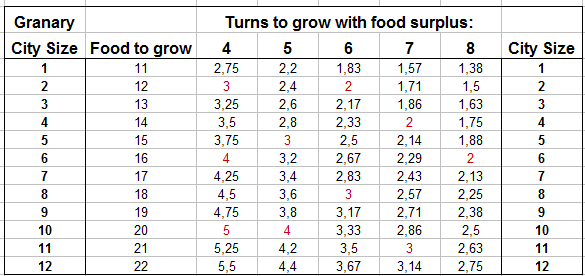There's no break point or mine valuation for me, i whip when that makes more sense..
example, granary 2-pop whip at size 4.
2 good food tiles. Would i not whip now (at a good point for bin filling) because of the green mine?
Of course you'd whip as soon as you could. I already pointed out that prioritizing better tiles than a mine beats just working the mine. In this case, if you didn't whip you'd just grow into unhappiness and get stuck whipping anyway, and with a worse

to

ratio than with a granary due to its impact on regrowth.
You'd have to compare an additional tile against the nearly doubled

to

conversion of your best 2 tiles. Whipping that is going to win, even if the "conversion" is less there's simply more stuff. That's exactly why you do it.
Honestly, these calculations often stop people from taking the better decision.
Only if one does them improperly

. If the city would struggle to grow into its

or

cap the whip might make less sense in your example, or rather you might wait until you ran out of mines if your *only* goal were to max production in that city and there were no other good cities to settle/capture sooner at all.
When it comes to planning though, things aren't that simple. You might whip away a pretty good tile so you can work 2 better ones (via settling) sooner, and that will easily come out ahead. In that case, you're not comparing working the mine in the current city to the whip, but rather working the mine in the current city to working a grassland cow and a copper mine in another city for example. Working those 2 tiles is more efficient than working a grassland mine.
It's also quiet obvious that when you whip heavily (units for example), simple 3 food farms can be better than 1f 4h special mines for a short time.
Interesting what you're saying here, and I bolded the pluralization for emphasis. If you sit at pop 1-->2 then whip forever, then for 3.67 turns you get nothing, then on the 4th turn you get 30

...averaging out to 8.2

/turn from the tile over extended time. 1F 4H is "only" 6.7

/turn if you whip from pop 2 constantly.
But that ignores an important consideration: you can get more

by working both and whipping from 3 --> 2 than by chain whipping 2 --> 1 from a single farm...unless you have even more tiles.
When you say "short time", you mean it. In this case the "long run" is quite close, so if you're whipping that 1F 4H tile away, there better be a pretty good reason (IE working an even better tile, or an imminent threat of some variety), because otherwise you'd just work it too and whip something less valuable.
IMO where people make a big mistake in these calculations is *opportunity cost* - specifically the potential gain from working a different and much better tile somewhere else. Planning for potential yield from all cities and potential cities in tandem is probably the hardest part of this game.



 to 3
to 3 conversion from the whip, the most efficient whip will be 1
conversion from the whip, the most efficient whip will be 1 or not working the better tile (IE any 4
or not working the better tile (IE any 4 . If the city would struggle to grow into its
. If the city would struggle to grow into its  or
or